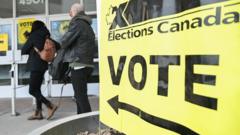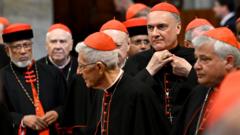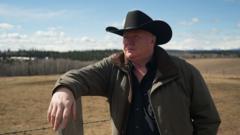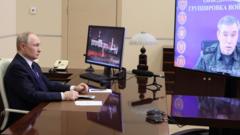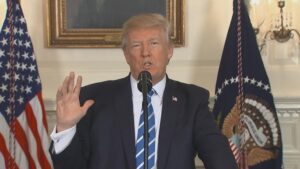As Canada's election approaches, the Liberal and Conservative leaders rally support, emphasizing differing approaches to the U.S. under President Trump. With polls indicating a close race, both Carney and Poilievre adjust their messages to resonate with voters in this critical moment.
Canada Faces Pivotal Election as Leaders Rally Support Amidst Trump Influence
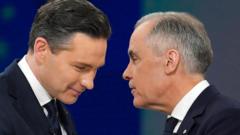
Canada Faces Pivotal Election as Leaders Rally Support Amidst Trump Influence
In a tight race for power, Canada's political future hangs in the balance as candidates Mark Carney and Pierre Poilievre seek to sway voters amidst U.S. tariff threats.
Article Text:
As the election nears, Canada finds itself at a critical crossroads, with the outcome increasingly influenced by international dynamics. On Friday, rallies in both London and the Toronto area showcased the high stakes of the campaign. Liberal leader Mark Carney warned attendees of President Trump's attempts to undermine Canadian sovereignty, inciting strong reactions from the crowd. Meanwhile, Conservative leader Pierre Poilievre has captured the energy of Canadians yearning for a change, emphasizing national patriotism against the backdrop of U.S. tariff threats.
The political landscape has shifted dramatically over recent months, with Carney rising through the ranks after Justin Trudeau's resignation. Initial predictions had placed the Conservatives comfortably ahead, but as the campaign progressed, the Liberals regained lost ground, presenting a more unified front against the looming presence of Trump.
Carney's economic acumen during his tenure at the Bank of Canada and the Bank of England has garnered support from those valuing stability against the uncertain backdrop of U.S. economic policies. Despite sharing many voters’ frustrations about the status quo, his opponents argue that he is merely the same party under new leadership. This sentiment resonates with voters like Gwendolyn Slover, highlighting a divide in perspectives on promises for change.
Polls suggest both major parties could secure over 38% of the vote share, raising the stakes for the smaller parties, since the New Democratic Party (NDP) and others have seen dwindling support. Jagmeet Singh, the NDP leader, advocates for strategic voting, attempting to harness the discontent with either of the two leading parties.
As the campaigns consolidate on economic issues, debates about climate change, immigration, and reconciliation appear less pronounced. Carney and Poilievre agree on the necessity of reducing U.S. dependencies, fostering resource sectors, and increasing defense spending, but they differ on the respective leadership styles needed to navigate these challenges.
In their final appeals to voters, both candidates emphasize their visions for the future. Carney asserts the need for experienced leadership, while Poilievre urges Canadians to embrace change, emphasizing their control over future paths. With election day on the horizon, the enthusiasm, skepticism, and hopes of Canadians will coalesce into decisive action at the polls.
As the election nears, Canada finds itself at a critical crossroads, with the outcome increasingly influenced by international dynamics. On Friday, rallies in both London and the Toronto area showcased the high stakes of the campaign. Liberal leader Mark Carney warned attendees of President Trump's attempts to undermine Canadian sovereignty, inciting strong reactions from the crowd. Meanwhile, Conservative leader Pierre Poilievre has captured the energy of Canadians yearning for a change, emphasizing national patriotism against the backdrop of U.S. tariff threats.
The political landscape has shifted dramatically over recent months, with Carney rising through the ranks after Justin Trudeau's resignation. Initial predictions had placed the Conservatives comfortably ahead, but as the campaign progressed, the Liberals regained lost ground, presenting a more unified front against the looming presence of Trump.
Carney's economic acumen during his tenure at the Bank of Canada and the Bank of England has garnered support from those valuing stability against the uncertain backdrop of U.S. economic policies. Despite sharing many voters’ frustrations about the status quo, his opponents argue that he is merely the same party under new leadership. This sentiment resonates with voters like Gwendolyn Slover, highlighting a divide in perspectives on promises for change.
Polls suggest both major parties could secure over 38% of the vote share, raising the stakes for the smaller parties, since the New Democratic Party (NDP) and others have seen dwindling support. Jagmeet Singh, the NDP leader, advocates for strategic voting, attempting to harness the discontent with either of the two leading parties.
As the campaigns consolidate on economic issues, debates about climate change, immigration, and reconciliation appear less pronounced. Carney and Poilievre agree on the necessity of reducing U.S. dependencies, fostering resource sectors, and increasing defense spending, but they differ on the respective leadership styles needed to navigate these challenges.
In their final appeals to voters, both candidates emphasize their visions for the future. Carney asserts the need for experienced leadership, while Poilievre urges Canadians to embrace change, emphasizing their control over future paths. With election day on the horizon, the enthusiasm, skepticism, and hopes of Canadians will coalesce into decisive action at the polls.








